
Hasegawa and Sword 1/72 T-34B and C Mentor
| KIT: | Hasegawa and Sword 1/72 T-34B and C Mentor |
| KIT #: | ? |
| PRICE: | $ |
| DECALS: | Two options in each kit |
| REVIEWER: | Joel Hamm |
| NOTES: | Both kits currently out of production but not difficult to find. |

| HISTORY |
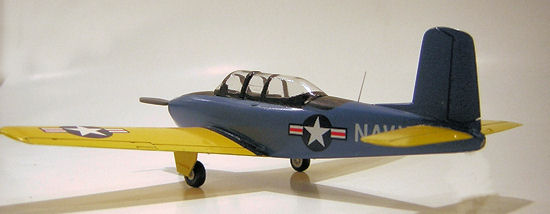 The T-34 was
developed in the early 1950’s from the civilian Model 35 Bonanza, as a
replacement for the venerable T-6 Texan. The services initially could not decide
whether to start students on piston engined aircraft or jump ab initio into
jets. Both the Navy and Air Force adopted it as a primary trainer but declined a
“hardened” armed version for counter insurgency and Forward Air Controller
roles. Several foreign countries did pick up on that option and continue to use
them. The USAF retired its T-34’s in the early 60’s in favor of pure jet
training on the T-37 “Tweety Bird”. The Navy continued using them until the mid
70’s then put in an order for the upgraded turbine engined version. This T-34C
is still the primary training aircraft for the US Navy and Marines, but is being
replaced by the T-6 Texan II.
The T-34 was
developed in the early 1950’s from the civilian Model 35 Bonanza, as a
replacement for the venerable T-6 Texan. The services initially could not decide
whether to start students on piston engined aircraft or jump ab initio into
jets. Both the Navy and Air Force adopted it as a primary trainer but declined a
“hardened” armed version for counter insurgency and Forward Air Controller
roles. Several foreign countries did pick up on that option and continue to use
them. The USAF retired its T-34’s in the early 60’s in favor of pure jet
training on the T-37 “Tweety Bird”. The Navy continued using them until the mid
70’s then put in an order for the upgraded turbine engined version. This T-34C
is still the primary training aircraft for the US Navy and Marines, but is being
replaced by the T-6 Texan II.
| THE KITS |
Hase’s Mentor was one of
it’s earliest releases around 30 years ago and represented a departure in
subject and substance from Revell, Monogram, and Airfix, which dominated the
hobby shop shelves back then. Primary trainers were not then in vogue; neither
was fall-together fit, flash-and-flaw-free molding, or see-through clear
canopies. The parts breakdown is sim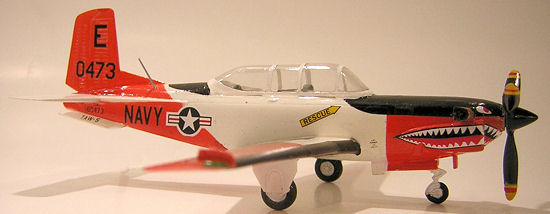 ple,
so simple that to justify the then exorbitant $3 price tag a bonus model of a
tow tractor is included. There are no molding boo-boos and the raised surface
detail is adequate.
ple,
so simple that to justify the then exorbitant $3 price tag a bonus model of a
tow tractor is included. There are no molding boo-boos and the raised surface
detail is adequate.
Sword is (was?) one of the MPM consortium of Czech kitters that specializes in off-the-beaten-track subjects. The box brags “Short Run Technology”, though the mercantile advantage expected from that boast is unclear. Main parts are molded mainstream without defects, but finer points, such as wheels and struts, are far behind the level achieved a score and a half years prior by the Japanese. The canopy is injected and smooth but slightly milky, a defect unimproveable by polishing but slightly ameliorated by a coating of Future. Two of the propeller blades were broken from the hub, but that was mox nix as the kit designer was apparently unaware that PT-6 powered props come to rest in the full feathered position. A detailed cockpit assembly is provided as a single resin casting, holding everything including 2 finely molded control sticks, which promptly broke away and departed the scene, to be replaced by wire snippets.
| CONSTRUCTION |
The Hasegawa kit, as
mentioned, fell together without need of filler, clamping, or filing. Nothing
noteworthy can be written, 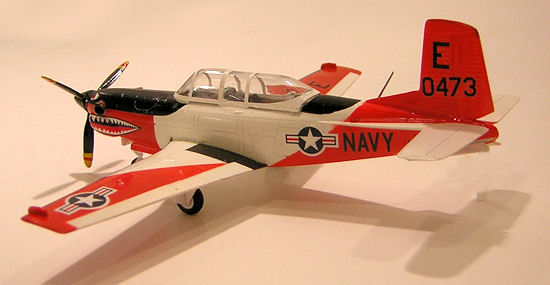 save
that with the short nose and long moment arm aft of the main gear, and despite a
full load of lead shot in the engine compartment, the prospect is hopeless of
inducing the plane to rest properly on its nose wheel. (Your editor had to put
additional lead in the nose gear well to get his to not tail-sit)
save
that with the short nose and long moment arm aft of the main gear, and despite a
full load of lead shot in the engine compartment, the prospect is hopeless of
inducing the plane to rest properly on its nose wheel. (Your editor had to put
additional lead in the nose gear well to get his to not tail-sit)
Sword’s hose-nosed turbine version promised to be better behaved in that respect, but both ultimately had to be supported upright on the display shelf by unobtrusive tail props, and in the accompanying photographs by the levitating magic of Photoshop’s clone brush. Airframe assembly wasn’t “fall together”, but neither was it “short run technology” a-la Meikraft or Merlin. Wing root gaps had to be closed with stri stock to avoid excessive dihedral. Nose scoops needed tweaking and careful alignment. No filler or heroic sanding efforts were called for, though.
| COLORS & MARKINGS |
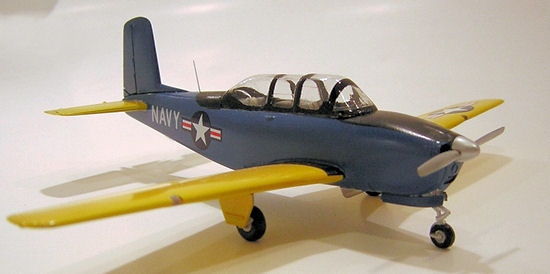 Hasegawa’s early
kits brought a new standard of molding to the hobby, but made no advancements in
decals. By modern standards they were useless. The paint scheme diagramed was
for a bare metal Air Force trainer, but I decided to go Navy yellow, as in
Testors little square bottles. Beaucoup images were available via Google, but
after applying the numerous decals from various spare sheets, the plane looked
a mess. I hosed it with Easy Lift Off solvent and decided to go for a simpler
livery. The blue and yellow design came from a picture of a civilianized warbird
on the Trade-a-Plane site. I can’t swear that it was ever painted that way while
in uniform, but it was attractive and simple and demanded only a shallow dive
into the spare markings box.
Hasegawa’s early
kits brought a new standard of molding to the hobby, but made no advancements in
decals. By modern standards they were useless. The paint scheme diagramed was
for a bare metal Air Force trainer, but I decided to go Navy yellow, as in
Testors little square bottles. Beaucoup images were available via Google, but
after applying the numerous decals from various spare sheets, the plane looked
a mess. I hosed it with Easy Lift Off solvent and decided to go for a simpler
livery. The blue and yellow design came from a picture of a civilianized warbird
on the Trade-a-Plane site. I can’t swear that it was ever painted that way while
in uniform, but it was attractive and simple and demanded only a shallow dive
into the spare markings box.
The turbo mentor’s
complicated, angular paint scheme made masking a chore, and overspray cleanup a
minor nightmare. 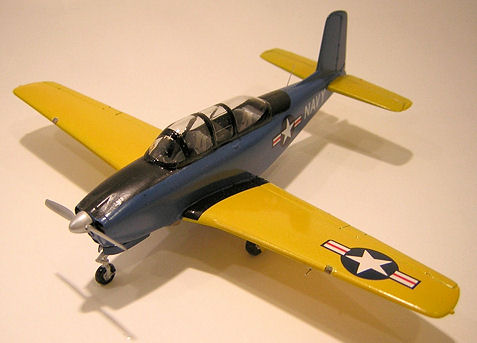 The precise
proper shade of orange was nowhere documented. Eyeballing the box art and web
images led to a choice of Model Master international orange; a bit garish in
bright light, but properly muted in the shade of the display shelf.
The precise
proper shade of orange was nowhere documented. Eyeballing the box art and web
images led to a choice of Model Master international orange; a bit garish in
bright light, but properly muted in the shade of the display shelf.
The kit decals, by Techmond, are thicker than the state of the art calls for. They slide into position and settle down well enough on flat surfaces, but refuse to conform to compound curves. The refusal of the sharks mouth markings, despite dousing with multiple setting solutions, to snuggle down around the nose scoops, threatened the project with CFIT (Controlled Flight Into Terrain). As a last resort I tried, with wonderful results, 70% isopropanol on the decals and 20% ethanol down my gizzard ( Dewars is to be preferred “neat”). Even after multiple soakings with Solvaset, the carrier film showed prominent silvering in oblique lighting. Early in my modeling career I determined that a heavy clear coat can disguise a cruddy paint and decal job. The theory being that enough light is reflected to temporarily (permanently if enough Future is used) blind an overly discerning viewer.
| FINAL CONSTRUCTION |
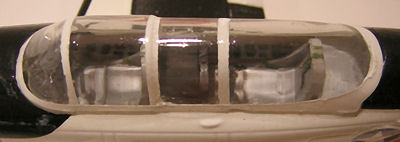 This is getting repetitious,
but in Hase’s case – nothing significant to report. Stick some masking tape
belts to the seats, glue on the canopy, stick on wheels, doors, prop, and it’s
done. Hardest part was fudging landing light lenses out of quick-set epoxy,
rather than fiddle with the nubs off the clear parts sprue.
This is getting repetitious,
but in Hase’s case – nothing significant to report. Stick some masking tape
belts to the seats, glue on the canopy, stick on wheels, doors, prop, and it’s
done. Hardest part was fudging landing light lenses out of quick-set epoxy,
rather than fiddle with the nubs off the clear parts sprue.
The Sword kit presented a few
challenges, as the small parts were amorphously molded. The nose gear with its
integrally molded tire was replaced by an exact dupe from a previously wrecked
Hasegawa kit. The main gear and wheels from that derelict couldn’t be found-
possibly donated to another plane, so a reasonable set of alternative wheels
replaced those from the kit, which had prominent ejector pin holes where the
tire meets the rim. The kit failed to include the cowl to the rear instrument
panel, but this 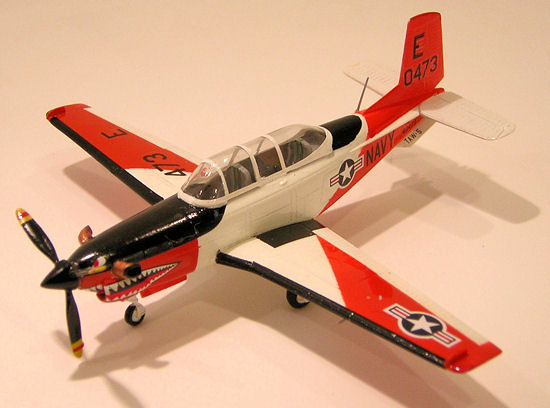 was easily cut
and bent from thin sheet. A replacement propeller came from a boneyard OV-10
Bronco, Hasegawa’s, Ithink. The blades had to be rounded and twisted to full
feather, then inserted into the kit’s spinner, after that had its nasty sink
hole filled and smoothed.
was easily cut
and bent from thin sheet. A replacement propeller came from a boneyard OV-10
Bronco, Hasegawa’s, Ithink. The blades had to be rounded and twisted to full
feather, then inserted into the kit’s spinner, after that had its nasty sink
hole filled and smoothed.
Several hours were spent trying to form decent looking exhaust stacks to replace the overblown and mis-shaped kit parts. Aluminum tubing would have worked well, had I been able to get a sharp enough bend without kinking. Hollow core solder would have solved the bending problem, but I had used the last millimeter on the roll re-sweating some loose pipe fittings feeding the Secret Model Airplane Building room and wasn’t up for 20 mile round trip to the nearest hardware store. I ended up bending and hollowing out some sprue. The shape may not be exact, but it’s close enough.
The box art depicted several antennae and wing protrusions for which there were neither parts on the sprue not evidence in Google images. I settled for a pitot tube cut from a wire staple, and whip antenna of pulled sprue.
| CONCLUSIONS |
If someone will kindly kit us a 1/72 LTV TT-1 Pinto and Beechcraft T-6 Texan II we can have a representation of the unbroken line of US primary trainers, from present all the way back to the Jenny.
March 2008
If you would like your product reviewed fairly and quickly, please contact me or see other details in the Note to Contributors.